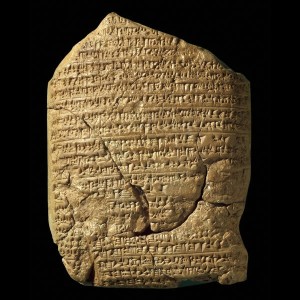 The Destruction of Samaria
The Destruction of Samaria
“On the twenty-fifth day of the month of Tebet Shalmaneser (V) ascended the throne in Assyria <and Akkad>. He ravaged Samaria.”
Date- 722 BCE
Current Location- British Museum, London, England (BM 92502)
Language and Script- Neo-Babylonian?; cuneiform
General Information-
Shalmaneser V succeeded Tiglath-Pileser III but ruled the Neo-Assyrian Empire for only five years (727-2 BCE). Because Assyrian records from his reign are quite meager, the most useful piece of historical information from his reign—at least regarding biblical history—comes from a series of texts known as the Babylonian Chronicle. Unlike royal inscriptions and annals, which boast of the accomplishments of an individual king, these texts dryly list the major political events in Babylonia year by year. Since they seem to have been aimed at recording history, some scholars consider them to be a more reliable historical source, on the assumption that they are less likely to have been tainted by nationalistic bias. In time, they cover from at least 745 BCE until the mid-3rd century BCE, but because of their fragmentary state, many years are missing. It is not entirely clear when these chronicles were composed. For Shalmaneser V’s reign, the relevant text in this series is Chronicle 1. When a usurper seized the throne of Babylonia during the reign of Tiglath-Pileser III, the Assyrian king removed him and took the throne for himself. Upon Shalmaneser V’s ascension to the throne, he continued the dynasty as king of both Assyria and Babylonia. For this reason, his acts are recorded in the chronicle, even though it generally contains only the activities of Babylonian kings.
Relevance to Ancient Israel-
In the ninth year of Hoshea, the king of Assyria captured Samaria. He deported the Israelites to Assyria and settled them in Halah, at the [River] Habor, at the River Gozan, and in the towns of Media. (2 Kings 17-6)
Chronicle 1 tells us that, simply, “[Shalmaneser V] shattered Samaria.” The biblical account is somewhat ambiguous here, saying both that “the king of Assyria” besieged Samaria (2 Kings 17-5), and that this same king captured the city and exiled its inhabitants (17-6). According to the extra-biblical sources, while Shalmaneser did besiege and capture Samaria, it was his successor Sargon II who exiled the inhabitants of the northern kingdom. Since it is the case that the Bible is not concerned much with Assyrian affairs, it would seem to be appropriate to let the extra-biblical sources stand as more factually precise in this case.
Circumstances of Discovery and Acquisition- This series of texts is designated as the Babylonian Chronicle by modern scholars, capturing their essential purpose. Most of the tablets that make up the Babylonian Chronicle are in the British Museum. The first text from this series to be published appeared in 1887, and subsequent publications since then have made the rest of the known texts available.